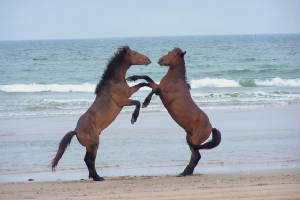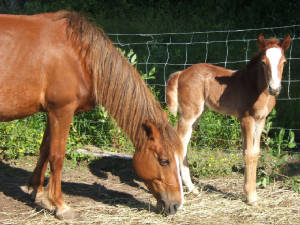Corolla Program
When the English settlers landed at Jamestown in 1607, they were not the only descendants of Europeans in the New World. Spanish explorers had been in the Gulf Coast and Florida for nearly 100 years. A generation before the landing at Jamestown, Spanish explorers established an outpost on the York River in eastern Virginia. The Spanish were not pedestrians. Many came mounted on the best horses of Europe.

Since that time, the descendants of these beautiful horses have roamed wild on the Outer Banks of North Carolina. In the 1920s, as many as 6,000 Spanish mustangs covered the beaches and dunes of the sparsely inhabited region. Today, fewer than 125 roam free near Corolla-with another band roaming free at Shackleford Banks, over 150 miles to the south. The wild horses of Corolla are protected by the Corolla Wild Horse Fund.
At Mill Swamp Indian Horses, we are spearheading an effort to keep America’s oldest distinct breed of horses from going extinct.
We are actively encouraging the adoption of these docile, highly-trainable horses, and are further seeking out breeders who would be willing to participate in a breeding program to save these horses. For further information please send Steve an e-mail: msindianhorses@aol.com.
Saving a Dying Breed
Wild mustangs have been roaming the Outer Banks of North Carolina for several hundred years. Descendants of horses brought to the New World by Spanish colonists; they numbered over six thousand as recently as the 1920’s. Now only two herds remain wild on the Outer Banks, the Corolla herd that numbers less than 125 and the Shackleford herd of approximately the same size located 175 miles to the south near Beaufort, North Carolina.
For several days in late February, a team of inspectors from the Horse of Americas Registry and the American Indian Horse Registry studied the two herds to determine whether they still demonstrated the characteristics of the ancient Spanish horses. The inspection included views of the horses in the wild along with observations of a few captive horses from each herd. The team searched the Corolla Wild Horse Sanctuary looking for skeletal remains order to confirm that the herd was composed of horses that bore the unique vertebra of the original horses of the Spanish colonists. Several skeletons were found and the official report of the team of inspectors made it clear that the horses are just what they have been reputed to be—descendants of Colonial Spanish horses.
Steve Edwards and Rebecca Stevenson were invited to join the team of inspectors on behalf of the American Indian Horse Registry. Edwards had previously been granted the opportunity to adopt a young Corolla stallion. Manteo, a wild colt who was removed from the herd for emergency surgery, became the only Corolla stallion in captivity who was available for breeding. Edwards was quickly taken with the colt.

“We got him home at 4:15 and he was completely halter trained in 45 minutes. Within twenty four hours he comfortably wore a saddle and took a child on his back,” according to Edwards.
Manteo was soon joined by Baton Rouge, a three-year-old mare who went from wild horse to gentled trail mount in a little over three weeks. A few weeks later, the Director of the Corolla Wild Horse Fund asked Edwards to take in a mature stallion who was removed from the herd because he had learned to escape the sanctuary and enter the town of Corolla.
“He came to us on March 2 and took a rider within a week,” he said of the stallion.
Edwards, who has trained wild mustangs captured from the western ranges, marveled at the gentle nature of their eastern cousins. “So far, it appears that they are much easier to train than any domestic horses that I have run into.”
Edwards was not the only member of the inspection team impressed with the wild horses of the Outer Banks. Vickie Ives, of the Texas-based Karma Farms, adopted a filly from Corolla and within a few weeks of the expedition had agreed to adopt a young stallion along with a mare that was captured with him. By doing so, she raised the number of breeding age Corolla stallions in captivity to three.
These captive horses may become part of the foundation stock of Corolla horses of the future. The management plan for the wild herd at Corolla requires the herd to be maintained at a level of 60 horses or less. According to Edwards, sixty horses are not enough to provide the genetic diversity to keep the breed alive. “Most experts agree that at least 120 horses is the minimum number to provide a healthy breeding program.”
With that in mind, he is seeking to develop a pool of breeders who will work to create a healthy breeding population of domesticated Corolla horses. He actively promotes the adoption of these horses from the Corolla Wild Horse Fund and urges all adopters to promptly register their horses with the Horse of the Americas Registry so a close check can be kept on the bloodlines. Recognizing that not all breeders are in a position to maintain a stallion on their property, he will offer his stallion’s breeding service free of charge to any owner of a Corolla mare.
To visit the Corolla Wild Horse Fund Website Click Here